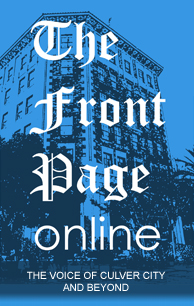It’s tempting to view art, in whatever form it takes, with skepticism, to dig up the bones of Dadaists long gone and point out art’s failure as a force for social transformation. And with good reason: Art, indeed, has failed. For all the poets waxing poetic about poetry, writers proclaiming the power of the novel, painters exulting new visions, film critics singing the praises of cinema – for all that, art still hasn’t succeeded in saving us from the worst in ourselves. How many war films are there? War novels? War poems? In this beginning of the 21st century, we have more access to art communicating, representing and illustrating the horrors of war than ever. Yet we have Iraq. We have Israel and Palestine.
A ‘National Treasure’ with Issues Gets Only a Little Right
Review: “National Treasure: Book of Secrets”
Like both sides of a frosted mini-wheat in an argument, Fred and Erik discuss the merits of “National Treasure: Book of Secrets.”
Fred: I see “National Treasure: Book of Secrets” scored 35 percent at Rotten Tomatoes.
Erik: Probably for the same reasons the first one scored 41 percent. But so what? I really liked it. I had a good time.
Fred: Really?
Erik: Yeah! You didn’t?
Culver High’s One-Act Festival Opens an 8-Night Run at the Frost
Culver City High School’s theatre students return to the stage of the venerable Robert Frost Auditorium this evening at 7, inaugurating a series of eight performances through Saturday, Jan. 19.
The Academy of Visual and Performing Arts’ Theatre Performance and Theatre Design students will be putting theory into practice when they present the first annual Blurred Vision Theatre Company One-Act Festival.
On alternating nights, two separate one-act programs will be staged, each for four performances.
National Treasure: Book of Secrets – Worth Reading?
Like both sides of a frosted mini-wheat in an argument, Fred and Erik discuss the merits of “National Treasure: Book of Secrets.”
Review: “National Treasure: Book of Secrets”
Review: The Orphanage
Warning! The following may contain spoilers…
“The Orphanage” is very much a traditional ghost story with traditional elements of the genre: A large, gloomy house with plenty of nooks, crannies, creaks and groans; a narrative structure founded on a mystery to be solved, namely, discovering the violent, traumatic event underlying the ghostly activity; a child sensitive to the presence of ghosts; and others. It is actually in some of these other elements that the film’s function as a ghost story critically compromises itself.
Culver High’s One-Act Festival
Culver City High School’s theatre students return to the stage of the venerable Robert Frost Auditorium this evening at 7, inaugurating a series of eight performances through Saturday, Jan. 19.
‘Sweeney Todd’: A Conflict — I Wanted to Love It More Than I did
Review: Sweeney Todd: The Demon Barber of Fleet Street
Tim Burton promised blood, and blood he delivers. When the incredible tension anticipating Sweeney’s first kill is finally cut, Burton’s slit-throat ballet is grisly and poetic, a Grand Guignol used to often haunting effect. Blood, so central to the visual vocabulary Burton employs to tell the story, is the only vivid splash in an otherwise dark and gloomy world – London. More Gotham than Gotham, the film’s London is an irredeemably corrupt black hole in the titular character’s eyes and, by extension, our own. Blood is the life, as the adage goes, and when it spills, the eventual loss of that colour to the oppressive black and blues of Dariusz Wolski’s gorgeous cinematography makes the spilling all the more shocking.
When Visiting ‘The Orphanage,’ Take a Careful Look at the Resolution
Review: The Orphanage
Warning! The following may contain spoilers…
“The Orphanage” is very much a traditional ghost story with traditional elements of the genre: A large, gloomy house with plenty of nooks, crannies, creaks and groans; a narrative structure founded on a mystery to be solved, namely, discovering the violent, traumatic event underlying the ghostly activity; a child sensitive to the presence of ghosts; and others. It is actually in some of these other elements that the film’s function as a ghost story critically compromises itself.
Foreign Film Series Will Open at the Landmark
Stephen Farber, film critic for Movieline’s Hollywood Life and The Hollywood Reporter as well as a regular contributor to The New York Times and Los Angeles Times, is offering his first-ever foreign film series, beginning Monday, Jan. 14, at the Landmark Theatre. As with his wildly popular REELTalk series, the series will bring together new films and fascinating discussions with actors, directors, filmmakers and industry executives.
‘I Am Legend’ — Smart with an Unbearable Feeling of Loneliness
Cinema has developed a very specific vocabulary for post-apocalyptic stories: Deserted streets, decrepit technologies, nature’s return to power, ruined landmarks. Although Richard Matheson’s novel “I Am Legend” was first published in 1954, this third adaptation of the story, after “The Last Man On Earth” and “The Omega Man,” makes excellent use of the imagery offered by films released after the novel. There’s a bit of “12 Monkeys” in Francis Lawrence’s vision of a world depopulated by a virus, and “28 Days Later,” and “The Quiet Earth,” and many others. But for all the tried and true vocabulary, Lawrence succeeds in overcoming the familiarity to deliver something unsettling and melancholy. When the last remaining human on earth, military virologist Dr. Robert Neville (Smith), scavenges lifeless homes for survival resources, we get a glimpse of interrupted lives —
